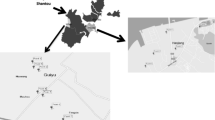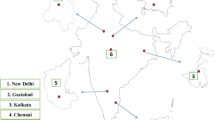Abstract
Electronic waste (e-waste) contains a variety of toxic substances that can be released into the surrounding environment and adversely affects human health when a primitive recycling process is used. This research aims to investigate the concentrations of lead and cadmium in soil and in the blood of workers at e-waste recycling facilities, to examine the correlation between the concentrations of lead and cadmium in soil and in the blood of the workers and to assess the health risks from the exposure of lead and cadmium in the soil at the e-waste recycling facilities. The results of this study showed that the concentrations of lead and cadmium found in the soil were 1.150 ± 0.00–2866.97 ± 31.54 and 0.181 ± 0.00–0.200 ± 0.00 mg/kg, respectively. The concentrations of lead were over the standard limit in Thailand. Moreover, the concentration of lead in the soil correlated to that in the blood of the workers. The concentration of lead in the men’s blood was two times higher than in the women’s blood. Lead and cadmium concentrations in smokers’ blood were higher than that in the non-smokers. The determinations of lead and cadmium exposure among workers at e-waste recycling facilities were 1.54 × 10−6–6.28 × 10−3 and 9.05 × 10−8–2.27 × 10−7 mg/kg, respectively. The greatest Hazard Quotient (HQ) of lead exceeded 1.74, signifying that high exposure of lead might pose a potential health risk to workers in e-waste recycling facilities.
Similar content being viewed by others
References
Akortia E, Olukunle OL, Daso AP, Okonkwo JO (2017) Soil concentrations of polybrominated diphenyl ethers and trace metals from an electronic waste dump site in the Greater Accra Region, Ghana: implications for human exposure. Ecotoxicol Environ Saf 137:247–255
Amankwaa EF, Tsikudo KAA, Bowman JA (2017) ‘Away’ is a place: The impact of electronic waste recycling on blood lead levels in Ghana. Sci Total Environ 601–602:1566–1574
Bi C, Zhou Y, Chen Z, Jia J, Bao X (2018) Heavy metals and lead isotopes in soils, road dust and leafy vegetables and health risks via vegetable consumption in the industrial areas of Shanghai, China. Sci Total Environ 619–620:1349–1357
Chabukdhara M, Nema AK (2013) Heavy metals assessment in urban soil around industrial clusters in Ghaziabad, India: probabilistic health risk approach. Ecotoxicol Environ Saf 87:57–64
Department of Disease Control (2004) Thai biological exposure indices. Ministry of Public Health, Thailand
Frazzoli C, Orisakwe OE, Dragone R, Mantovani A (2010) Diagnostic health risk assessment of electronic waste on the general pollution in developing countries’ scenarios. EIA Rev 30:388–399
Grandjean P, Olsen NB, Hollnagel H (1981) Influence of smoking and alcohol consumption on blood lead levels. Int Arch Occup Environ Health 48:391–397
Ha NN, Agusa T, Ramu K, Tu NPC, Murata S, Bulbule KA, Parthasaraty P, Takahashi S, Subramanian A, Tanab S (2009) Contamination by trace elements at e-waste recycling sites in Bangalore, India. Chemosphere 76:9–15
Han W, Gao G, Geng J, Li Y, Wang Y (2018) Ecological and health risks assessment and spatial distribution of residual heavy metals in the soil of an e-waste circular economy park in Tianjin. China Chemosphere 197:325–335
Healey N, Jones-Otazo H, Walker M, Knafla A (2010) Toxicological Review and Recommended Toxicological Reference Values for Lead Exposure in Canada. Report prepared for Health Canada. Healthy Environments and Consumer Safety Branch, Environmental Health Bureau, Ottawa
Jarup L, Berqlund M, Elinder CG, Nordberg G, Vather M (1998) Health effects of cadmium exposure—a review of the literature and a risk estimate. Scan J Work Environ Health 24(Suppl 1):1–51
Julander A, Lundgren L, Skare L, Grander M, Palm B, Vahter M, Liden C (2014) Formal recycling of e-waste leads to increased exposure to toxic metals: an occupational exposure study from Sweden. Environ Int 73:243–251
Khassouani CE, Soulaymani R, Mauras Y, Allian P (2000) Blood cadmium concentration in the population of the Rabat area, Morocco. Clin Chim Acta 302:155–160
Kiddee P, Bunmak S (2016) Drivers and barriers of electronic waste management in Thailand. NSRU Sci Tech J 8(8):145–158
Kiddee P, Naidu R, Wong H (2013) Electronic waste management approaches: an overview. Waste Manage 33:1237–1250
Kim SH, Kim YH, An HC, Sung JH, Sim CS (2017) Levels of blood lead and urinary cadmium in industrial complex residents in Ulsan. Ann Occup Environ Med 29:26–33
Lemly AD (1996) Evaluation of the hazard quotient method for risk assessment of selenium. Ecotoxicol Environ Saf 35:156–162
Luo C, Liu C, Wang Y, Liu X, Li F, Zhang G, Li X (2011) Heavy metal contamination in soils and vegetables near an e-waste processing site, south China. J Hazard Mater 186:481–490
Nabulo G, Young SD, Black CR (2010) Assessing risk to human health from tropical leafy vegetables grown on contaminated urban soils. Sci Total Environ 480:5338–5351
National Environmental Board (2004) Announcement of the National Environmental Board, Issue 25 (2004), Thailand
Oguri T, Suzuki G, Matsukami H, Uchida N, Tue MN, Tuyen LH, Viet PH, Takahashi S, Tanabe S, Takigami H (2018) Exposure assessment of heavy metals in an e-waste processing area in northern Vietnam. Sci Total Environ 621:1115–1123
Puckett J, Smith T (2002) Exporting Harm: the high tech trashing of Asia. The Basel Action Network, Silicon Valley Toxics Coalition
Singh M, Thind PS, John S (2018) Health risk assessment of workers exposed to the heavy metals in e-waste recycling sites of Chandigarh and Ludhiana, Punjab, India. Chemosphere 203:426–433
U.S. EPA (1989) Risk assessment Guidance for Superfund Volume I: Human Health Evaluation Manual (Part A). EPA/540/1–89/002 December 1989
U.S. EPA (2004) Integrated Risk Information System (IRIS) Chemical Assessment Summary: Lead and Compounds (inorganic) CASRN 7439-92-1. https://www.epa.gov/iris. Accessed 6 Aug 2017
U.S. EPA (2011) Exposure factors handbook: 2001 edition (Final Report). US Environmental Protection Agency, Washington, DC. EPA/600/R-09/052F, 2011
VROM (2000) Dutch target and intervention values: soil quality standards, Netherlands Ministry of Housing. Spatial Planning and Environment, Department of Soil Protection, The Hague
Wang Q, He AM, Gao B, Chen L, Yu QZ, Guo H, Sh BJ, Jiang P, Zhang ZY, Li PL, Sheng YG, Fu MJ, Wu CT, Chen MX (2011) Increased levels of lead in the blood and frequencies of lymphocytic micronucleated binucleated cells among workers from an electronic-waste recycling site. J Environ Sci Health 46:669–676
Wong MH, Wu SC, Deng WJ, Yu XZ, Luo Q, Leung AOW, Wong CSC, Luksemburg WJ, Wong AS (2007) Export of toxic chemicals – a review of the case of uncontrolled electronic-waste recycling. Environ Pollut 149:131–140
Wu Q, Leung JYS, Geng X, Chen S, Huang X, Li H, Huang Z, Zhu L, Chen J, Lu Y (2015) Heavy metal contamination of soil and water in the vicinity of an abandoned e-waste recycling site: Implications for dissemination of heavy metals. Sci Total Environ 506–507:217–225
Yang H, Huo X, Yekeen TA, Zheng Q, Zheng M, Xu X (2013) Effect of lead and cadmium exposure from electronic waste on child physical growth. Environ Sci Pollut Res Int 20:4441–4447
Zhang K, Schnoor JL, Zeng EY (2012a) E-waste recycling: where does it go from here? EnvironSci Technol 46:10861–10867
Zhang R, Xu C, Shen H, Meng J (2012b) Oxidative and immunotoxicity effect of people who exposed to electronic waste. J Hyg Res 41:199–203
Zheng L, Wu K, Li Y, Qi Z, Han D, Zhang B, Gu C, Chen G, Liu J, Chen S, Xu X, Huo X (2008) Blood lead and cadmium levels and relevant factors among children from an e-waste recycling town in China. Environ Res 108:15–20
Acknowledgements
The authors wish to thank National Research Council of Thailand and Research and Development Institute Thaksin University (Project no. R01-181513) for the financial support of this study. Finally, the authors would like to thank Dr. Foyfa Shutidamrong and Mr. Christopher Joseph Forti (English adviser and English proof reader, Thaksin University) for suggestions on the language and structure of manuscript.
Author information
Authors and Affiliations
Corresponding author
Rights and permissions
About this article
Cite this article
Kiddee, P., Decharat, S. Risk assessment of lead and cadmium exposure from electronic waste recycling facilities in Southern Thailand. Environ Earth Sci 77, 456 (2018). https://doi.org/10.1007/s12665-018-7648-3
Received:
Accepted:
Published:
DOI: https://doi.org/10.1007/s12665-018-7648-3




